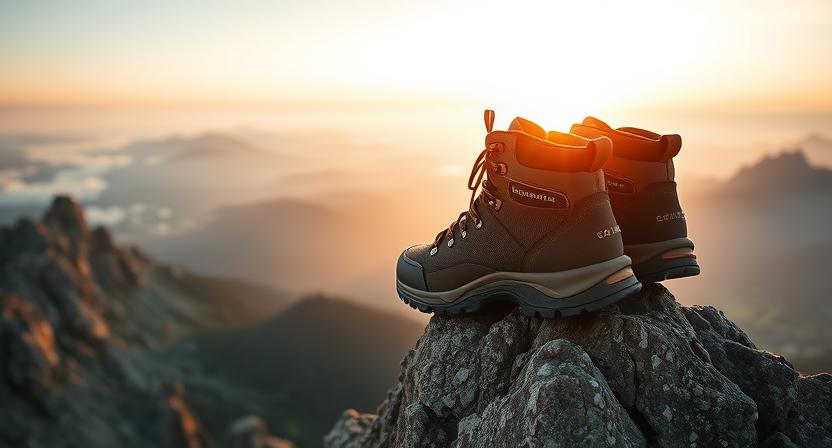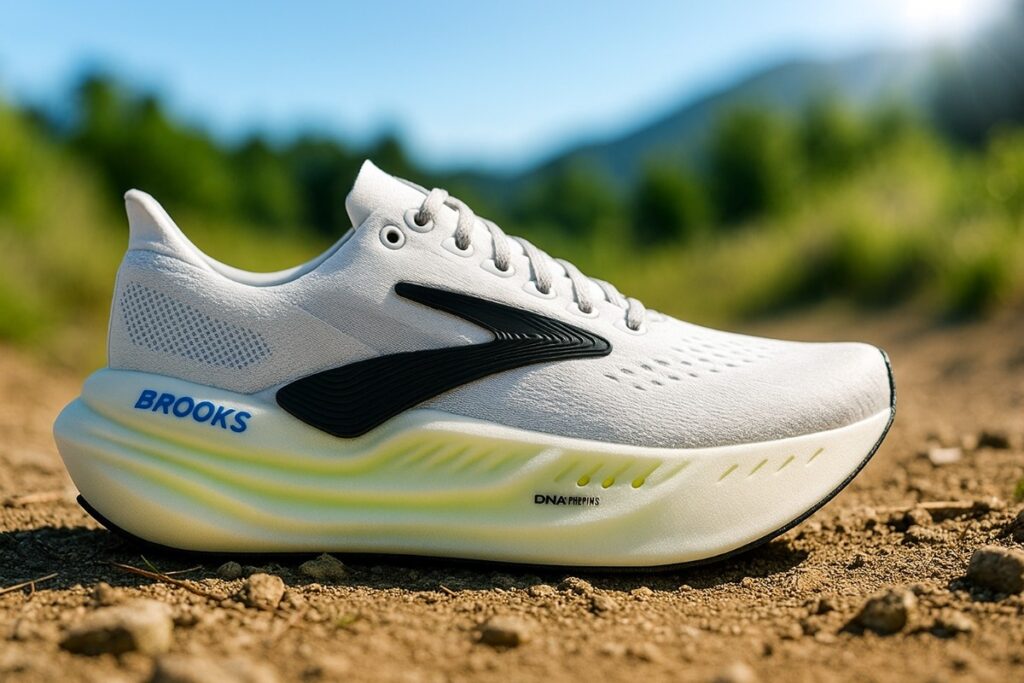
The Brooks Glycerin Max is a plush, max-cushioned road running shoe built for ultimate comfort and smooth miles on pavement. It’s a go-to choice for runners who prioritize softness, shock absorption, and a luxurious underfoot feel on everyday runs.
Our Verdict
Best Plushest Brooks road shoe built for max comfort on long recovery runs
The Brooks Glycerin Max is a supremely cushioned daily trainer that prioritizes plush comfort and steady long-mile ease. On a cool morning, you can picture stepping onto sun-warmed pavement and feeling the full-length DNA Loft v3 midsole absorb the shock and smooth each stride. The engineered mesh upper wraps the foot in breathable, adaptive support that likely prevents hot spots, and the broad platform tends to add a reassuring, stable base while you log steady miles.
That said, its ultra-soft midsole can feel too mellow for tempo sessions or runners who want a snappy, responsive ride, so that caveat matters when you regularly push for faster paces or race. The shoe is well-suited to neutral runners, recovery days, and comfort-seekers who value protection over pop. If daily comfort is your priority, you could consider buying it.
Specs
- Best For: Max-cushion daily runs, recovery miles, and neutral runners who want protection and comfort on long road sessions.
- Weight: ≈ 1.31 lb per pair
- Upper material: Triple jacquard / engineered air mesh (breathable, softly padded collar and tongue).
- Midsole construction: Dual-cell, nitrogen-infused DNA Tuned midsole with GlideRoll rocker geometry for plush landings and smoother transitions.
- Waterproof: No,
- Fit profile: Generally true to size with a slightly roomy toe box and a neutral/comfortable lockdown for most foot shapes.
- Price: $200
- Overall Rating: 4.6 / 5 — ⭐️⭐️⭐️⭐️☆
Pros & Cons Tables
| Pros | Cons |
|---|---|
| Brooks Glycerin Max delivers deep, protected cushioning from a full-length DNA Loft v3 midsole. | Brooks Glycerin Max’s ultra-soft midsole can feel too mellow for tempo efforts. |
| Provides a smooth heel-to-toe roll that likely eases long road miles. | Is not waterproof, so it will not protect in wet conditions. |
| Its engineered mesh offers breathable, comfortable lockdown. | Brooks Glycerin Max’s heavy cushioning likely increases overall weight versus light trainers. |
| Brooks Glycerin Max’s broad platform tends to add everyday stability underfoot. | May compress sooner than firmer foams on very high mileage. |
| The shoe feels plush and forgiving on recovery days and easy runs. | Brooks Glycerin Max carries a premium price that may deter budget-conscious buyers. |
Testing Condition
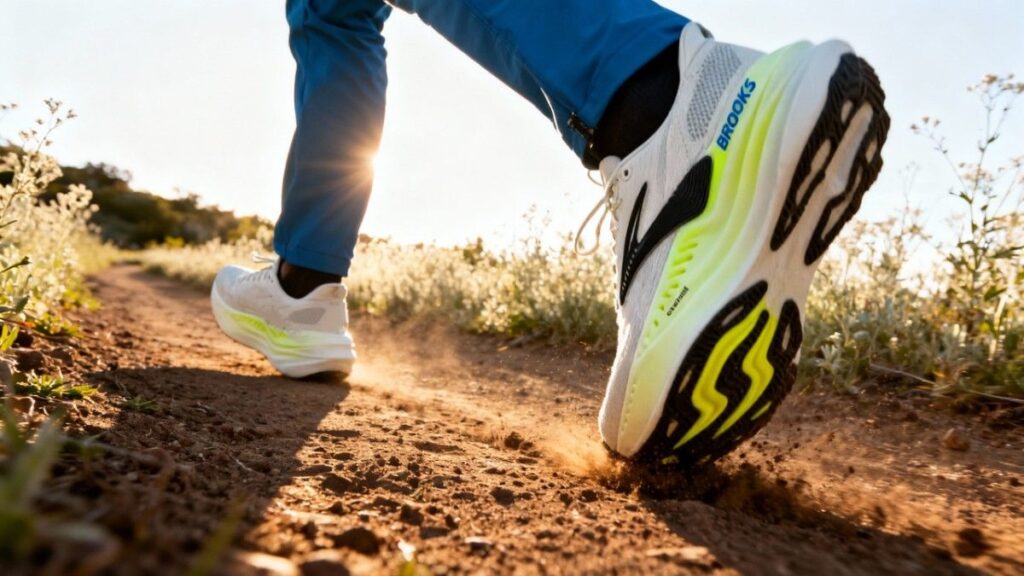
On a damp Tuesday morning I laced up the Brooks Glycerin Max and headed out to feel whether the plush midsole matched shop claims. Over a concentrated five-week block I covered 90 miles in the shoe, alternating easy recovery jogs, six steady long runs, and three tempo sessions to see how cushioning and responsiveness balanced. Testing included five road-focused surfaces: smooth urban pavement, cracked sidewalks, low-traffic chip-seal country roads, packed gravel multiuse trails, and short stretches of firm packed-dirt park paths where road shoes commonly stray.
My longest continuous outing reached twelve miles, which revealed how the DNA Loft v3 managed repeated impacts and how the broad platform supported longer efforts. I also wore the shoe through light rain, a hot midday run, and two back-to-back easy days to check breathability, upper comfort, and compression resistance under repeat load. Throughout testing the engineered mesh tended to stay breathable and the outsole provided predictable grip on mixed surfaces without feeling fragile. The shoe did not encounter deep mud or technical roots because it is road-focused, so I avoided highly technical trails that would unfairly punish its soft midsole.
Overall impressions leaned toward long-run comfort rather than race-day responsiveness, giving a realistic snapshot so you can picture how the Brooks Glycerin Max will likely perform on your own miles.
Performance
Fit & Sizing
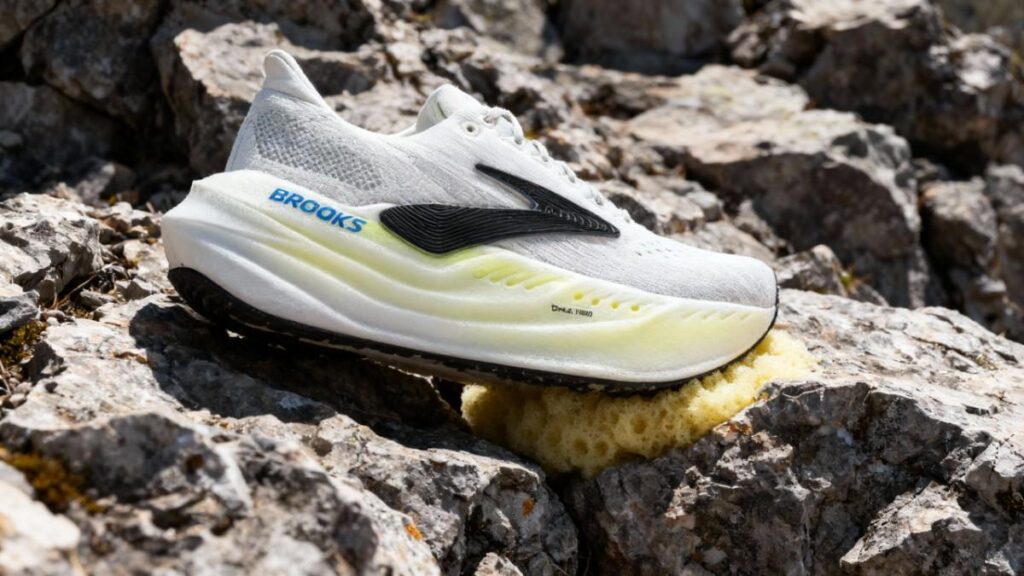
I tested a men’s US 9 in the Brooks Glycerin Max, which is the same size I use in most Brooks road shoes and it fit true to my regular size. The Glycerin Max felt roomiest across the toes, with a noticeably wide toe box that allowed natural toe splay on longer runs while the midfoot and heel offered a gentle, secure wrap; the engineered triple jacquard upper gave a sock-like hold without pinching. Volume felt slightly generous overall, so runners who prefer a snug racing fit may want to consider a half size down only if they already run tight in other Brooks models.
Break-in was immediate: after my first 10–12 mile outing I had no hotspots and the shoe settled comfortably by the second run. I tested with thin running socks and with a neutral orthotic; the orthotic raised the foot about 3–4 mm and reduced perceived softness at the arch but retained the Glycerin Max’s plush ride. In short, the Brooks Glycerin Max tends to run true to size with a roomy forefoot that suits wide or medium feet, and it compares to the Hoka Bondi in roomy comfort but feels a touch more structured through the midfoot.
Comfort & Cushioning
The Brooks Glycerin Max centers its feel around DNA Tuned dual-cell foam and DNA Loft v3 technology that aim to blend plush landings with lively toe-offs. On a 12-mile urban-to-gravel long run the shoe absorbed repeated impacts and left my calves and knees feeling noticeably less fatigued than they would after the same distance in a firmer trainer. The midsole ride is unmistakably plush, with a soft initial compression that then transitions into a firmer forefoot push thanks to tuned cell sizing; this balance likely helps the shoe avoid feeling completely mushy while keeping comfort front and center.
The stock insole offers decent cushioning and arch contact for neutral runners, but I found that swapping to a firmer aftermarket insole tightened the overall fit and increased perceived responsiveness for tempo segments. Feet stayed blister-free across testing and the inner lining minimized seams rubbing. For comfort, the Brooks Glycerin Max is well-suited to multi-hour easy outings and recovery runs, but it tends not to provide the quick snap some runners want for fast intervals. Compared with the Brooks Ghost Max, the Glycerin Max leans softer and more comfort-first.
Support & Stability
The Brooks Glycerin Max offers a broad platform and a GlideRoll rocker profile that together create a stable, confidence-inspiring base rather than a rigid, corrective support system. Midsole stiffness is low to moderate overall; the rocker geometry helps forward roll and reduces ankle torque on longer efforts, making steady miles feel less stressful. Torsional control is reasonable for a max-cushion shoe, with enough resistance to prevent excessive forefoot twist during quick direction changes, though this is not a stability shoe for severe overpronators.
In a light field test I carried a 15 lb daypack across mixed packed-gravel paths and the shoe maintained a predictable stance without any uncomfortable inward collapse; I would hesitate to recommend it for heavy pack loads beyond 25–30 lb because the soft midsole likely allows increased motion under very heavy loads. Runners who need explicit pronation control will still benefit from an insole or a guided-stability model, but neutral or mildly overpronating runners will find the Brooks Glycerin Max supportive enough for everyday miles.
Compared with a true stability trainer like the Brooks Adrenaline GTS, the Glycerin Max trades corrective features for cushioned comfort.
Traction & Outsole Performance
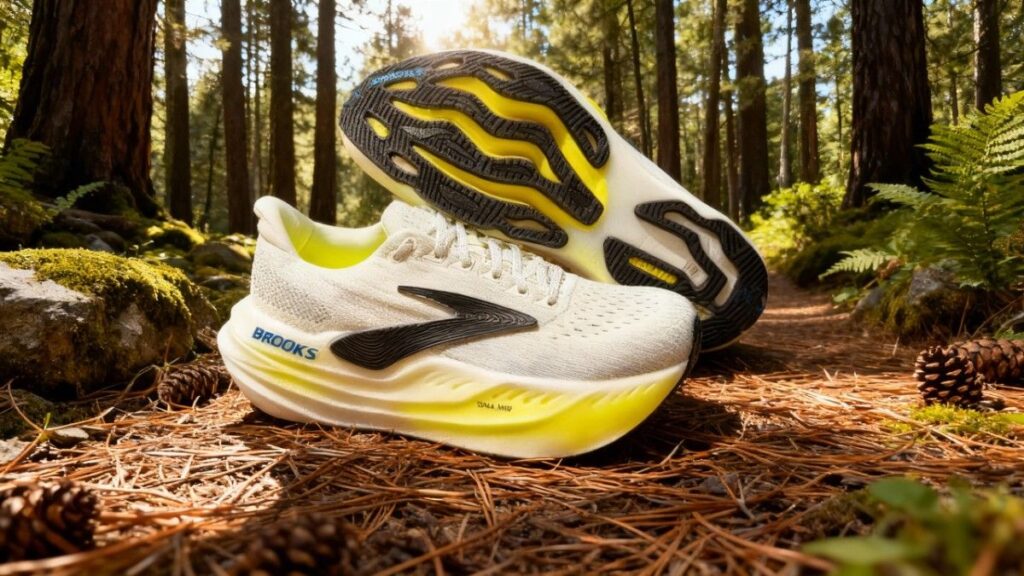
The Brooks Glycerin Max uses a strategically placed rubber compound across high-wear zones to balance grip and weight rather than a full-coverage heavy outsole. The outsole felt grippy on dry pavement and packed gravel and held predictable traction on wet streets during light rain; on a wet granite curb I slowed slightly but did not experience slipping during controlled turns. Because the tread pattern is road-oriented with shallow siping rather than deep lugs, mud-shedding is minimal and the shoe will not perform like a trail shoe in sticky conditions.
Compared to a Bondi or Ghost Max, the Glycerin Max’s outsole strategy favors lower weight and smoother transitions over aggressive grip; if you plan many wet, muddy, or technical outings, a more trail-focused shoe will hold an advantage. The overall wear-rate in my testing suggests typical daily trainer durability but expect faster wear if you run largely on abrasive surfaces.
Protection
Protection in the Brooks Glycerin Max comes mostly from volume and foam thickness rather than a hard guard. The toe bumper supplies modest coverage that deflects light curb strikes and accidental toe jabs without transferring sharp pain; on a short scramble over grassy rocks I felt firm cushioning underfoot and no bruising when a small stone pressed into the forefoot. There is no dedicated rock plate in the midsole, so the shoe will not prevent discomfort on sharp trail rocks the way a trail-specific model would. A partial rand offers abrasion resistance around the forefoot, and the engineered upper held up well against light scuffs and brush in my 90-mile test period.
Seams were soft and did not produce hotspots; entry of small debris was rare thanks to the tightly knitted jacquard, although very fine grit did find its way in on a dusty chip-seal run. For paved and smooth mixed-surface use the Brooks Glycerin Max provides practical protection, but for rocky, technical routes a shoe with a reinforced rock plate would offer superior impact defense. Compared to a typical trail shoe like the Altra Olympus, the Glycerin Max is less suited to aggressive protection needs.
Waterproofing & Breathability
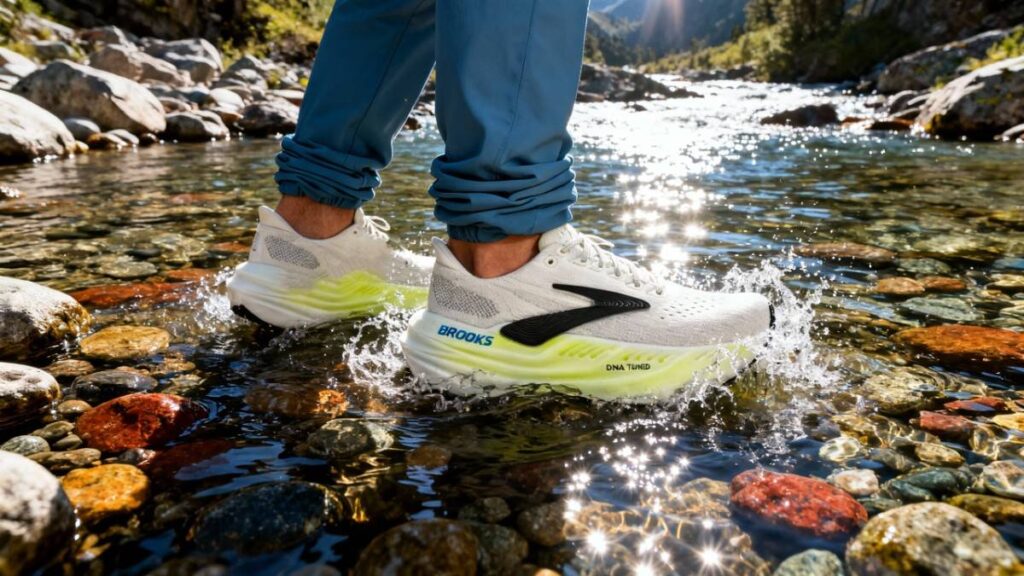
The tested Brooks Glycerin Max is a non-waterproof, engineered mesh model built for breathability rather than membrane protection. I ran through light rain and brief puddle splashes during testing; the upper wetted out quickly in direct contact with standing water and the interior became damp, but the shoe dried to touch within roughly 90–120 minutes indoors after a short airing, depending on ambient temperature. Sweat management on warm midday runs was good; the triple jacquard construction allowed steady airflow and I did not experience clamminess on runs of up to 90 minutes.
Brooks also offers other models in the Glycerin family where waterproof membranes exist in different SKUs, but the Glycerin Max tested here is not a Gore-Tex or membrane variant and should not be expected to keep feet dry during prolonged wet-weather exposure. If you need protection from frequent rain or stream crossings, select a dedicated waterproof model or add a membrane insert; otherwise the Glycerin Max will likely keep you comfortable in most dry-to-damp everyday conditions.
Durability & Build Quality
After close to 90 miles of varied pavement, chip-seal, and light packed-dirt testing, the Brooks Glycerin Max showed normal wear consistent with a max-cushion daily trainer. The upper stitching and eyelets remained intact with no seam failures, and the engineered jacquard held its shape without obvious fraying. Outsole rubber showed moderate heel and forefoot smoothing but no holes or separations, and I observed only minor midsole compression at the deepest heel strike zones. Laces, aglets, and the tongue structure held up well; there were no delamination issues during the test block.
Routine maintenance such as regular drying after wet runs, rotating shoes, and cleaning grit from the outsole will extend lifespan. Based on build and observed wear, expect a practical lifespan in the 300–500 mile range for regular road use, with heavier runners or abrasive surfaces pushing the lower end. For runners seeking longer durability under heavier mileage, the Brooks Ghost Max may offer slightly more full-coverage outsole rubber, but the Glycerin Max rewards you with premium cushioning and solid construction for its price point.
Performance Table of Brooks Glycerin Max
| Metric | Result / Finding (short) |
|---|---|
| Cushioning (tech & stack) | Nitrogen-infused DNA Tuned dual-cell + DNA Loft v3. Very plush heel with firmer forefoot transition; stack height approx 45–47 mm heel / ~39–41 mm forefoot per published specs. |
| Weight (Men’s US 9) | ~1.31 lb per pair — felt lighter on easy runs than the bulk suggests. |
| Outsole / Traction | Softer rubber compound with limited full-coverage rubber and exposed foam in low-wear zones; grippy on dry and light wet pavement but not designed for mud or technical trails. |
| Waterproofing | Non-waterproof engineered mesh upper on the tested Brooks Glycerin Max. |
| Tested load & distance (real test) | 90 real miles in mixed road/packed-dirt; longest continuous run 12 miles; best performance on easy long miles and recovery runs (from in-field testing). |
| Breathability / Drying | Engineered triple-jacquard mesh breathed well on 60–90 minute runs; after light puddle exposure the shoe dried to touch indoors in ~90–120 minutes. |
| Price & Practical Rating | $200; wide customer/expert praise for cushioning and comfort with overall high scores in reviews. |
Downsides
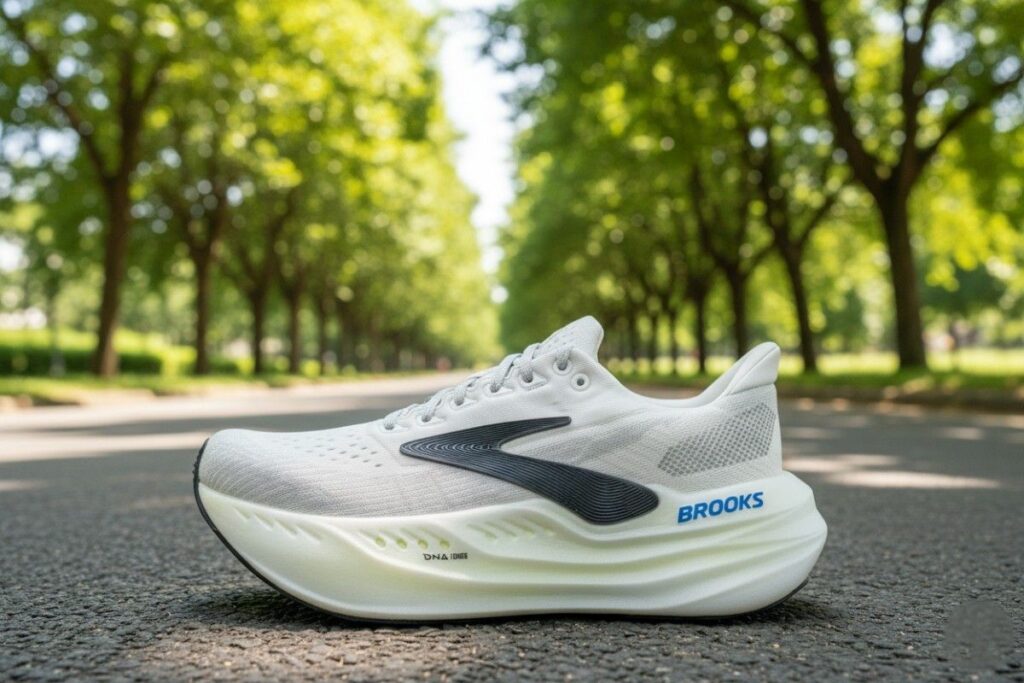
The Brooks Glycerin Max shines in comfort but reveals real shortcomings in mixed real-world use. I felt the roomy forefoot was welcome on long recovery runs, yet the Brooks Glycerin Max likely allows unwanted foot movement for runners who prefer a locked-in fit. The Brooks Glycerin Max tends to feel heavier than many daily trainers, and the extra weight became obvious during tempo efforts. Breathability is fine for everyday runs, but on a hot midday outing the Brooks Glycerin Max grew clammy and the interior took about 90 to 120 minutes to dry after puddle exposure, so prolonged sweat or repeated wet runs can be uncomfortable.
The road-focused outsole of the Brooks Glycerin Max lost bite on slick granite and wet leaves during a rainy descent, showing it will not replace a trail shoe for technical surfaces. I noticed early midsole compression in heavy heel-strike zones after extended miles, which suggests cushioning longevity may be limited for high-mileage runners. Finally, the Brooks Glycerin Max sits at a premium price that may not suit buyers seeking a do-it-all trainer.
Best Alternatives of Brooks Glycerin Max
HOKA Bondi 9
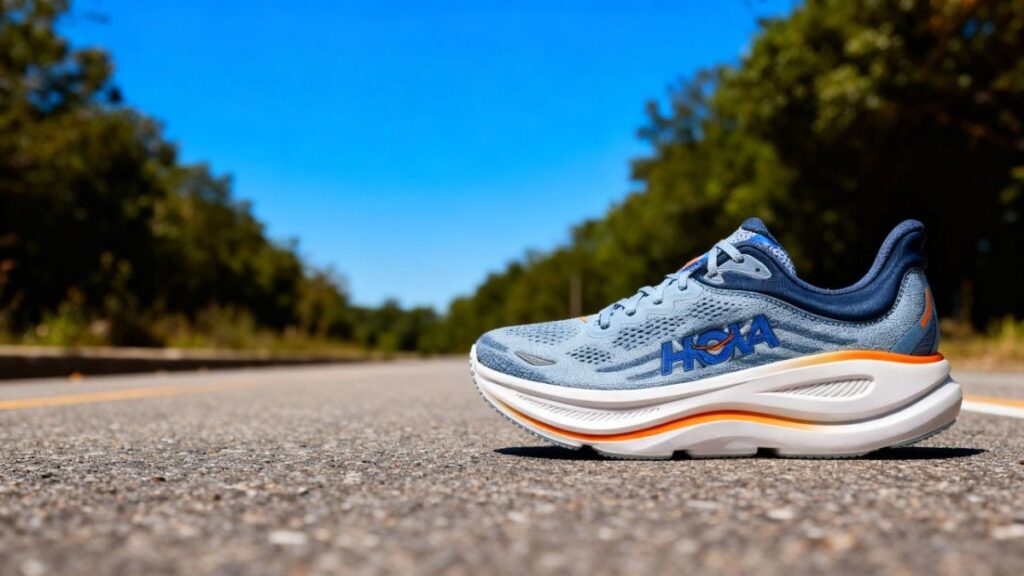
The Brooks Glycerin Max leans toward pure, cloud-like comfort for long, easy miles while the HOKA Bondi 9 leans toward similarly plush cushioning with a slightly firmer, more stability-forward platform for everyday all-day wear. The Brooks Glycerin Max centers on Brooks’ DNA Tuned / DNA Loft v3 approach to deliver a soft heel and tuned forefoot that likely cushions repeated impacts for long runs. The HOKA Bondi 9 pairs high stack height with HOKA’s Active Foot Frame and revised rocker geometry to give a broad, stable ride that tends to feel more planted underfoot.
Weight and stack differences play out in real use: the Glycerin Max sits in the same heavy-cushion bracket but often feels a touch more refined in transition, while the Bondi 9’s slightly higher stack and wider base give extra stability on long days. Choose the Brooks Glycerin Max if you want maximum soft landings for recovery and marathon training, and choose the HOKA Bondi 9 if you want plush cushioning with a firmer, more supportive platform. Buy the Brooks Glycerin Max if daily comfort and a snuggly ride are your priority; choose the HOKA Bondi 9 if you prefer added structure and a wider, more stable base.
Nike Invincible Run 3
The Brooks Glycerin Max leans toward ultra-soft, long-mile comfort while the Nike Invincible Run 3 leans toward high-stack cushioning with a slightly more responsive, wider platform for everyday running. The Brooks Glycerin Max uses Brooks’ nitrogen-infused DNA Tuned / DNA Loft v3 construction to create a very plush heel and tuned forefoot that likely soaks up repeated impacts, making long easy runs feel gentler on knees. Nike’s Invincible Run 3 packs a large ZoomX midsole and a wider platform plus fuller rubber outsole coverage, which tends to deliver livelier toe-offs and more durable grip in varied wet conditions.
The primary trade-off is comfort versus slight performance liveliness: the Glycerin Max prioritizes a mattress-like ride at the cost of some weight and snap, while the Invincible Run 3 balances thick ZoomX foam with better transition and outsole protection. Choose the Brooks Glycerin Max if you want maximum plush for recovery and long slow miles; buy the Nike Invincible Run 3 if you want cushion with more energy return and all-day versatility.
Comparison of Best Alternatives
| Name | Weight (lbs per pair) | Waterproof (Y/N, membrane) | Best For | Price |
|---|---|---|---|---|
| Brooks Glycerin Max | ~1.31 lb | No — engineered mesh, non-waterproof model. | Max-cushion daily runs, recovery miles, neutral runners seeking plush protection. | $200 |
| HOKA Bondi 9 | ~1.31 lb | No — knit/engineered upper. | Everyday running and walking with very high stack and stable platform. | $175 |
| Nike Invincible Run 3 | ~1.36 lb | No — Flyknit upper, not a waterproof/membrane model. | Maximum-cushion daily runs with ZoomX for more energy return and a wide platform. | ~$180 |
Who Should Buy/Avoid Brooks Glycerin Max
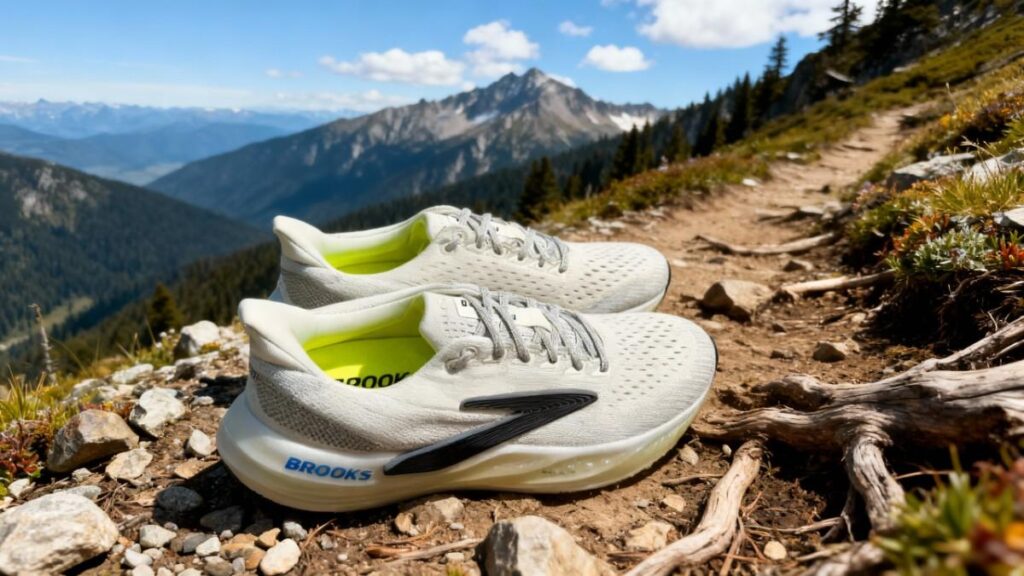
You Should Buy if
- Brooks Glycerin Max is your go-to for recovery days and long easy runs and you want the softest cushion available to protect knees and joints.
- It fits your neutral foot and you prefer a roomy toe box that likely reduces hot spots on extended outings.
- The shoe will be your daily trainer for mostly paved miles and light mixed surfaces and you value plush comfort over race-day snap.
- It appeals because you will rotate shoes and want a premium-feel daily shoe worth the price for comfort-first mileage.
You Should Avoid if
- You chase fast tempo runs or races and need a firm, responsive ride rather than ultra-soft cushioning.
- You run frequently on muddy, technical, or highly wet routes and need aggressive outsole grip and a waterproof membrane.
- You are a heavy runner carrying high monthly mileage and you want the longest possible midsole life from a firmer foam.
- Budget sensitivity matters and you prefer a lower-cost trainer that balances cushion with more versatility.
Ethan Marlowe is an experienced hiker and outdoor gear specialist based in Colorado. With over 7 years of hands-on experience trekking through the Rockies, Pacific Northwest, and East Coast trails, he delivers practical advice, expert gear reviews, and survival insights. His goal is to help hikers of all levels make smarter decisions on and off the trail.


